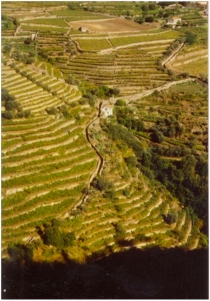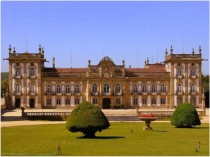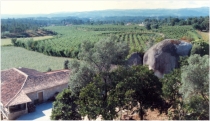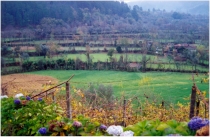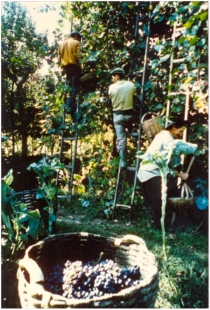Minho
Wine region: Vinho Verde (MINHO)
There are references to viticulture in the Vinho Verde region dating back to Roman times. At the beginning of modern times, the sub‑regions of Basto, Ribeira do Tâmega, Monção and Ribeira Lima were well‑known for their quality wine. The first exports of these wines left Monção and Ribeira Lima for England from the port of Viana at the beginning of the 16th century. The demarcation of various vitivinicultural regions began in 1908. Great progress was made in terms of quality in 1926, with regulations regarding production and distribution of “Vinho Verde” being established and the founding of the “Comissão de Viticultura da Região dos Vinhos Verdes” (Viticultural Commission of the Vinho Verde Region), the body responsible for initiating research under the leadership of Eng. J. Amândio Galhano into the choice of the best regional varieties adapted to their specific terroir, since this method had been successfully implemented in the middle of the previous century.
The Minho region covers the whole northwest of the country, an area traditionally known as Entre‑Douro‑e‑Minho (literally, “between the Douro and the Minho”) south of Spanish Galicia. The mountains in the east and south constitute a natural barrier as does the Atlantic Ocean to the west. It geographical location creates a very particular climate which differs from the rest of the country and is characterise by much wind, high rainfall and low insolation. Vineyards cover over 35,000 hectares, which is 12% of the total area under viticulture nation‑wide. According to the Comissão de Viticultura dos Vinhos Verdes (Vinho Verde Viticultural Commission), there are more than 1,500 different Vinho Verde labels.
A description of the region’s soil type appears in the IVV Yearbook 2010: “… most of this region rests on granite formations, with the exception of two narrows strips which run across it in a NW‑SE direction, one from the Silurian age characterised by carboniferous and slate formations, the other by archaic schist. The soils are shallow, have a sandy and sandy loam texture, high acidity, are low in phosphorus and high in potassium”.
“Three storey” agriculture combined with distinctive grapevine varieties and the vineyard conduction systems used results in wine with unique characteristics. While in the south of the country monoculture vineyards have traditionally had plants growing on the ground (necklaces) or without support (goblet) and very low trellises (Alentejo), in the Vinho Verde region vines often grow to a considerable height, resulting in a drastic reduction in alcohol content. The vines are planted along the edges of fields growing maize or other annual crops, using a pergola training system, staked high horizontal trellises (ramadas), or low horizontal trellises (bardos). If trained on living trees (uveiras) – mostly chestnut, poplar or plane – vines can reach a height of up to seven metres.
Modern vineyard conduction systems, which in themselves make mechanisation of labour possible, are based on various forms of cordon or the cross in order to maintain the typicity of the wine. With the modernisation of vine training systems, the alcohol content of the Vinho Verde has increased significantly (to just under the current EU alcohol content limit of 12% vol.), which has intensified the aromas in white wines and has given red wines internationally sought‑after characteristics.
The following nine regions whose products are covered by the Statutes of the Region Demarcated as Vinho Verde may be used in addition to the Designation of Origin certification: “Amarante”, “Ave”, “Baião”, “Basto”, “Cávado”, “Lima”, “Monção”, “Paiva” and “Sousa”.
Types of vitivinicultural products
Minho IG wine or Minho regional wine:Red, white, rosé, sparkling.
Vinho Verde DO (+ additional regional designations): Red, white, rosé, sparkling.
Vinho Verde DO sparkling wines (VEQPRD)
Aguardente de Vinho da Região dos Vinhos Verdes (Vinho Verde brandy from wine spirit)
Aguardente de Bagaceira da Região dos Vinhos Verdes (Vinho Verde grape marc spirit)
Vinagre de Vinho Verde (Vinho Verde vinegar)
Regional Contacts
Technical information: Comissão de Viticultura da Região dos Vinhos Verdes (“Viticultural Commission of the Vinho Verde Region”), Rua da Restauração 318, 4050‑Porto (link: www.vinhoverde.pt)
Cultural information on the wine of the region: Confraria do vinho verde (“Vinho Verde Society”) secretaria@confrariadovinhoverde.com Various regions intend to create viticultural museums.
Institutions of higher education: Universidade de Minho, Largo do Paço, 4704‑553 Braga, www.uminho.pt, Escola Superior Agrária de Ponte de Lima; www.esa.ipvc.pt
Certification authority:Comissão de Viticultura da Região dos Vinhos Verdes 4050‑501 PORTO Rua da Restauração, 318Tel. 00351 226077300; e‑mail: info@vinhosverde.pt; Website: www.vinhoverde.pt
Eno‑tourism information: Vinho Verde Wine Route, Tel. 226077300; Porto (Website: www.rota.vinhoverde.pt)

Producer and bottler information on wine from the Vinho Verde region: http://www.ivv.min‑agricultura.pt/np4/1736.html, → Yearbook pages 99–111. rota.vinhoverde.pt and the CVR (Comissão Vitivinícola Regional [“Regional Vitivinicultural Commission]): www.vinhoverde.pt.
Designation: IGP “Minho” (Regional wine)

Legislation: Ministerial Directive No. 112/93, Ministerial Directive No. 1202/97, Ministerial Directive No. 394/2001, (EC) 1493/99, Decree‑Law No. 212/2004.
Varieties:
RED WINES:Alfrocheiro, Alicante Bouschet, Alvarelhão, Amaral, Aragonez (Tinta Roriz), Baga, Borraçal, Cabernet Franc, Cabernet Sauvignon, Castelão (Periquita), Doçal, Doce, Espadeiro, Espadeiro Mole, Grand Noir, Jaen, Labrusco, Merlot, Mourisco, Padeiro, Pedral, Pical, Pinot Noir, Rabo de Anho, Sousão, Syrah, Tinta Barroca, Touriga Nacional, Trincadeira (Tinta Amarela), Verdelho, Tinto, Verdial Tinto and Vinhão.
WHITE WINES:Alvarinho, Arinto (Pedernã), Avesso, Azal, Batoca, Caínho, Cascal, Chardonnay, Chenin, Colombard, Diagalves, Esganinho, Esganoso, Fernão Pires (Maria Gomes), Folgasão, Godelho, Lameiro, Loureiro, Malvasia Fina, Malvasia Rei, Müller‑Thurgau, Pinot Blanc, Pintosa, Rabo de Ovelha, Riesling, São Mamede, Semilão, Sercial (Esgana Cão), Tália, Trajadura and Viosinho.
Designation: DOP “Vinho Verde” (VQPRD)

Legislation: Ministerial Directive No. 668/2010, Decree‑Law No. 212/2004. (EC) No. 1234/2007 (as amended by Reg. (EC) No. 491/2009).
RED WINES: Alvarelhão, Amaral, Borraçal, Espadeiro, Padeiro, Pedral, Rabo de Anho and Vinhão.
Subregions:
Amarante: Amaral, Borraçal, Espadeiro and Vinhão.
Ave: Amaral, Borraçal, Espadeiro, Padeiro and Vinhão
Baião: Alvarelhão, Amaral, Borraçal and Vinhão
Basto: Amaral, Borraçal, Espadeiro, Padeiro, Rabo de Anho and Vinhão
Cávado: Amaral, Borraçal, Espadeiro, Padeiro and Vinhão
Lima: Borraçal, Espadeiro and Vinhão
Monção: Alvarelhão, Borraçal, Pedral and Vinhão
Paiva: Amaral, Borraçal and Vinhão
Sousa: Amaral, Borraçal, Espadeiro and Vinhão.
WHITE WINES: Alvarinho, Arinto (Pedernã), Avesso, Azal, Batoca, Loureiro and Trajadura.
Subregions:
Amarante: Arinto (Pedernã), Avesso, Azal and Trajadura
Ave: Arinto (Pedernã), Loureiro and Trajadura
Baião: Arinto (Pedernã), Avesso and Azal
Basto: Arinto (Pedernã), Azal, Batoca and Trajadura
Cávado: Arinto (Pedernã), Loureiro and Trajadura
Lima: Arinto (Pedernã), Loureiro and Trajadura
Monção: Alvarinho, Loureiro and Trajadura
Paiva: Arinto (Pedernã), Avesso, Loureiro and Trajadura
Sousa: Arinto (Pedernã), Avesso, Azal, Loureiro and Trajadura



